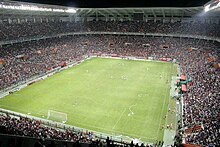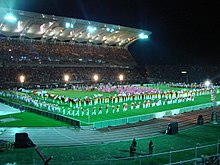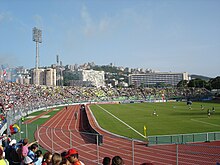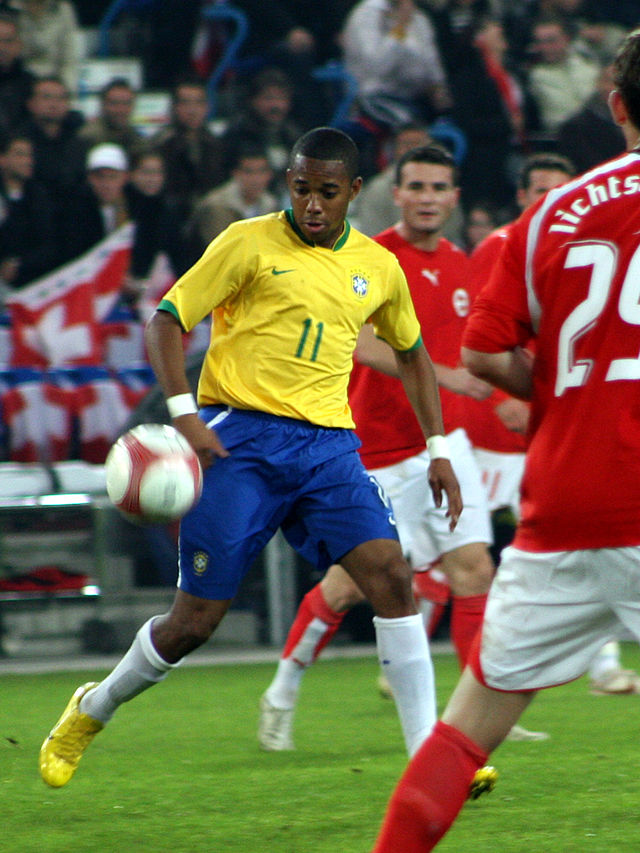Loading AI tools
International football competition From Wikipedia, the free encyclopedia
The 2007 Campeonato Sudamericano Copa América, known simply as the 2007 Copa América or 2007 Copa América Venezuela, was the 42nd edition of the Copa América, the South-American championship for international association football teams. The competition was organized by CONMEBOL, South America's football governing body, and was held between 26 June and 15 July in Venezuela, which hosted the tournament for the first time.
| Copa América Venezuela 2007 | |
|---|---|
 Copa América 2007 official logo | |
| Tournament details | |
| Host country | Venezuela |
| Dates | 26 June – 15 July |
| Teams | 12 (from 2 confederations) |
| Venue(s) | 9 (in 9 host cities) |
| Final positions | |
| Champions | |
| Runners-up | |
| Third place | |
| Fourth place | |
| Tournament statistics | |
| Matches played | 26 |
| Goals scored | 86 (3.31 per match) |
| Attendance | 1,050,230 (40,393 per match) |
| Top scorer(s) | |
| Best player(s) | |
| Best young player | |
← 2004 2011 → | |
The competition was won by Brazil (they were also the defending champions), who beat Argentina 3–0 in the final.[2] Mexico took third place by beating Uruguay 3–1 in the third-place match. Brazil thus won the right to represent CONMEBOL[3] at the 2009 FIFA Confederations Cup.[4]
As with previous tournaments, all ten members of CONMEBOL participated in the competition. In order to bring the number of competing teams to twelve, CONMEBOL invited Mexico and the United States, the two highest ranking CONCACAF teams in the FIFA World Rankings. Just as in every tournament since 1993, Mexico accepted the invitation. The United States rejected the invitation due to scheduling conflicts with the 2007 Major League Soccer season. CONMEBOL then proceeded to invite Costa Rica, the third highest CONCACAF team in FIFA's ranking.[5] In the end, the United States accepted the invitation.[6]
For this Copa América, the organizing committee decided to choose eight cities to hold the tournament. A total of 14 cities presented proposal before the committee, of which they rejected proposals from Barquisimeto, Maracay, Valencia, Valera, Portuguesa and Miranda for not meeting established requirements. The cities of Barinas, Caracas, Ciudad Guayana, Maracaibo, Maturín, Mérida, Puerto la Cruz and San Cristóbal were selected to host the tournament. Later on, the organizing committee reconsidered the candidacy of Barquisimeto, based on the proposal of a new stadium to be built for the city. With a final nine host cities, the 2007 edition broke the previous records for host cities set by the 2004 Copa América in Peru, which used seven.
| Maturín | Barquisimeto | Mérida | Ciudad Guayana |
|---|---|---|---|
| Estadio Monumental de Maturín | Estadio Metropolitano de Lara | Estadio Metropolitano de Mérida | Estadio Polideportivo Cachamay |
| Capacity: 52,000 | Capacity: 42,000 | Capacity: 42,000 | Capacity: 41,600 |
 |  |  |  |
| Maracaibo |
Location of the host cities of the 2007 Copa America. | ||
| Estadio José Pachencho Romero | |||
| Capacity: 40,000 | |||
 | |||
| San Cristóbal | Puerto la Cruz | Barinas | Caracas |
| Estadio Polideportivo de Pueblo Nuevo | Estadio Olímpico Luis Ramos | Estadio Agustín Tovar | Estadio Olímpico de la UCV |
| Capacity: 40,000 | Capacity: 38,000 | Capacity: 27,500 | Capacity: 24,900 |
 |
 |
 |
 |
On 30 May 2007, CONMEBOL announced the list of match officials for the competition. The list included one match official from every country (except Paraguay, which had two). From these thirteen, six officiated in the 2006 FIFA World Cup: Carlos Simon, Óscar Ruiz, Carlos Amarilla, Jorge Larrionda, and Armando Archundia.
The draw for the competition took place on 14 February 2007 in the Teresa Carreño Theater in Caracas.[7][8]
Each association had to present a list of twenty-three players to compete in the competition.
The first round, or group stage, saw the twelve teams divided into three groups of four teams. Each group was a round-robin of six games, where each team played one match against each of the other teams in the same group. Teams were awarded three points for a win, one point for a draw and none for a defeat. The teams finishing first, second and two best-placed third teams in each group qualified for the Quarter-finals.
Teams were ranked on the following criteria:
| Key to colors in group tables | |
|---|---|
| Group winners, runners-up, and best two third-placed teams advance to the quarterfinals | |
All times are in Venezuela Standard Time (UTC–4).
| Team | Pld | W | D | L | GF | GA | GD | Pts |
|---|---|---|---|---|---|---|---|---|
| 3 | 3 | 0 | 0 | 9 | 3 | +6 | 9 | |
| 3 | 2 | 0 | 1 | 8 | 2 | +6 | 6 | |
| 3 | 1 | 0 | 2 | 3 | 9 | −6 | 3 | |
| 3 | 0 | 0 | 3 | 2 | 8 | −6 | 0 |
| Paraguay | 5–0 | |
|---|---|---|
| Santa Cruz Cabañas |
Report |
| Colombia | 1–0 | |
|---|---|---|
| Castrillón |
Report |
| Argentina | 1–0 | |
|---|---|---|
| Mascherano |
Report |
At the end of the first stage, a comparison was made between the third-placed teams of each group. The two best third-placed teams advanced to the quarter-finals.
| Quarter-finals | Semi-finals | Final | ||||||||
| 7 July – San Cristóbal | ||||||||||
| | 1 | |||||||||
| 10 July – Maracaibo | ||||||||||
| | 4 | |||||||||
| | 2 (4) | |||||||||
| 7 July – Puerto la Cruz | ||||||||||
| | 2 (5) | |||||||||
| | 1 | |||||||||
| 15 July – Maracaibo | ||||||||||
| | 6 | |||||||||
| | 3 | |||||||||
| 8 July – Maturín | ||||||||||
| | 0 | |||||||||
| | 6 | |||||||||
| 11 July – Ciudad Guayana | ||||||||||
| | 0 | |||||||||
| | 0 | |||||||||
| 8 July – Barquisimeto | ||||||||||
| | 3 | Third place | ||||||||
| | 4 | |||||||||
| 14 July – Caracas | ||||||||||
| | 0 | |||||||||
| | 1 | |||||||||
| | 3 | |||||||||
| 2007 Copa América Champions |
|---|
Brazil 8th title |

With six goals, Robinho was the top scorer in the tournament. There were 86 goals scored in 26 matches, for an average of 3.31 goals per match.
6 goals
5 goals
4 goals
3 goals
2 goals
1 goal
1 own goal
| Goalkeeper | Defenders | Midfielders | Forwards |
|---|---|---|---|
| Pos | Team | Pld | W | D | L | GF | GA | GD | Pts | Eff |
|---|---|---|---|---|---|---|---|---|---|---|
| 1 | 6 | 4 | 1 | 1 | 15 | 5 | +10 | 13 | 72.2% | |
| 2 | 6 | 5 | 0 | 1 | 16 | 6 | +10 | 15 | 83.3% | |
| 3 | 6 | 4 | 1 | 1 | 13 | 5 | +8 | 13 | 72.2% | |
| 4 | 6 | 2 | 2 | 2 | 8 | 9 | −1 | 8 | 44.4% | |
| Eliminated in the quarterfinals | ||||||||||
| 5 | 4 | 2 | 0 | 2 | 8 | 8 | 0 | 6 | 50.0% | |
| 6 | 4 | 1 | 2 | 1 | 5 | 6 | −1 | 5 | 41.6% | |
| 7 | 4 | 1 | 1 | 2 | 5 | 8 | −3 | 4 | 33.3% | |
| 8 | 4 | 1 | 1 | 2 | 4 | 11 | −7 | 4 | 33.3% | |
| Eliminated in the first round | ||||||||||
| 9 | 3 | 1 | 0 | 2 | 3 | 9 | −6 | 3 | 33.3% | |
| 10 | 3 | 0 | 2 | 1 | 4 | 5 | −1 | 2 | 22.2% | |
| 11 | 3 | 0 | 0 | 3 | 3 | 6 | −3 | 0 | 0.0% | |
| 12 | 3 | 0 | 0 | 3 | 2 | 8 | −6 | 0 | 0.0% | |
Global Platinum Sponsor
Global Gold Sponsor
Global Silver Sponsor
Charitable Partner
Local Supplier
The official match ball for the tournament was the Nike Mercurial Veloci. The ball was presented on 14 February 2007, prior to a friendly match played between Venezuela and New Zealand, by the president of the Venezuelan Football Federation, Rafael Esquivel, to the mayor of Maracaibo, Giancarlo Di Martino – head of the local organising committee.

Guaky is a scarlet macaw, a bird representative of Venezuela. He wore the traditional jersey Venezuela national football team burgundy and football shoes. Under their wings the characteristic tricolor national flag, with its eight stars on their wings.
To choose the official mascot held a contest in which proposals received 4,500,000 of Venezuelan children and adolescents at a school. The winning draw corresponded to the 15-year-old Jhoyling Zabaleta.[10] The final design was commissioned to Fractal Studio, bring life and a "strong personality, cheerful and sport" that accompanied the event during its realization. The name of the pet, Guaky was subsequently elected by an online survey, where that option was a 54.17% of preferences.[11]
Seamless Wikipedia browsing. On steroids.
Every time you click a link to Wikipedia, Wiktionary or Wikiquote in your browser's search results, it will show the modern Wikiwand interface.
Wikiwand extension is a five stars, simple, with minimum permission required to keep your browsing private, safe and transparent.